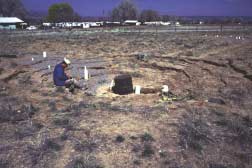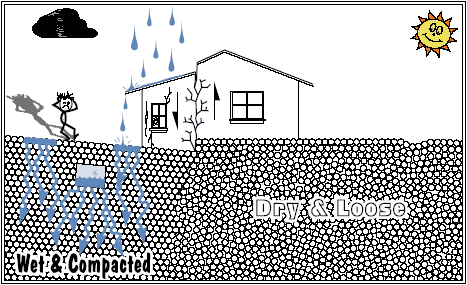
What Decision Makers Should Know About
Collapsible Soils in New Mexico
Background

Collapsible soils are soils that compact and collapse after they get wet. The soil particles are originally loosely packed and barely touch each other before moisture soaks into the ground. As water is added to the soil in quantity and moves downward, the water wets the contacts between soil particles and allows them to slip past each other to become more tightly packed. Water also affects clay between other soil particles so that it first expands, and then collapses like a house of cards. Another term for collapsible soils is "hydrocompactive soils" because they compact after water is added. The amount of collapse depends on how loosely the particles are packed originally and the thickness of the soil that becomes wetted. In one area of El Llano on the east side of Española, one collapsecrater feature was 150 ft across and 5 ft deep in the center. The loose soil originally was more than 50 ft thick. Its collapse literally split and tilted the foundations of two homes and threatened two more. The addition of water to the naturally dry soil was caused by a septic tank, a leaky municipal water line, runoff from roads, and runoff from the roofs of the houses nearby. Several other houses and other facilities in the same neighborhood were affected by addition of water near their foundations.
Collapsible soils are common in New Mexico. They have caused millions of dollars of damage to public facilities such as schools, highway maintenance buildings, jail facilities, water tanks, roads, and other infrastructure. Housing developments from Velarde to Las Cruces and from Alamogordo to Socorro have been subject to collapsible soils. Collapsible soils are likely to continue to plague unsuspecting homeowners. They have damaged some homes to the point of condemnation. Several would-be homeowners have had their houses condemned and have had to continue paying mortgages on houses that they can not live in nor repair. Developers have had to buy houses back from would-be homeowners after foundations were ruined by collapsible soils.
Collapsible soils develop on valley margins where soil particles move from the foothills toward the valleys. They commonly accumulate to tens of feet thick. As New Mexico's population has moved out of the well-watered and irrigated valleys with compact soils to develop the valley margins and foothills, the collapsible soils have made their presence known as the newcomers add water to the drier soils.
What Can Property Owners Do?

In areas that have not been developed, soils should be tested for collapsibility as well as other problems (shrink-swell potential, corrosiveness, and depth to bedrock). If collapsible soils are found, thin amounts may be removed and compacted with heavy machinery. If collapsible soils are thick, large tracts may be settled by prewetting the soils to depth before development takes place. Road right-of-ways may be compacted by repeatedly dropping heavy weights from a large crane along the route.
In areas that have already been developed and then are discovered to have collapsible soils, property owners should try to keep as much water as possible from seeping into the ground. This means xeriscaping rather than watering lawns and shrubbery, particularly near building foundations; installing municipal water and sewer lines rather than individual wells and septic tanks; and installing downspouts and storm-sewer lines to remove rainfall runoff from the area as quickly as possible. New foundations should follow construction guidelines of the Building Research Advisory Board (BRAB), developers of the BRAB slab, a reinforced "wafflelike" foundation that also prevents damage from shrink-swell soils. Pylons not on solid subsurface materials and "slurry jacking" do not work in collapsible soils.
What Can Geologists, Engineers, and Soil Scientists Do?
Collapsible soils may be suspected in undeveloped areas that have young, accumulating sandy and silty soils in dry areas. The soils may be confirmed to be collapsible through engineering testing. These tests include study of seismic waves through the soils, rates of drilling through the soils (blow counts), and testing undisturbed soil samples obtained by careful drilling for compaction after wetting. Unfortunately, these tests are expensive for individual property owners. Scientists need to develop better, less expensive ways of determining the extent of collapsible soils in the subsurface. Developers are required to file soil-engineering reports before development, but often tests for collapsible soils are not performed, and homebuyers rarely look at soil-engineering reports. More publicity about the presence of collapsible soils in New Mexico would help make the public more aware of the problem and make property sellers more apt to test and treat problem soils before they become a problem. It should be noted that collapsible soils are not the sole cause of surface subsidence in New Mexico; several other natural and humancaused processes may also cause the ground to collapse.
What Can Decision Makers Do?
The dilemma for decision makers is how to balance the protection of would-be buyers and users of property from the devastation of problem soils against the undue burden of expensive testing of soils regardless of the property's location. Some municipalities and counties have zoning restrictions that may aid in limiting some uses of some property or in requiring xeriscaping in developed areas that have experienced collapsible soils. All construction of public facilities should have proper subsurface testing and evaluation done before bidding takes place, and supervision of the site during the building phase. Xeriscaping makes sense for foundation safety regardless of the availability of water and rainfall runoff. Decision makers should insist on non-leaky waterlines and better municipal sewer and drainage systems to remove rainfall runoff from problem neighborhoods.
Where Can I Get More Information?
- Clemence, S. P., and Finbarr, A. O., 1981, Design considerations for collapsing soils: Journal of Soil Mechanics and Foundation Engineering, GT3, v. 107, p. 305–317.
- Johnpeer, G. D., Love, D. W., Hawley, J. W., Bobrow, D. J., Hemingway, M., and Reimers, R. F., 1985, El Llano and vicinity geotechnical study—final report: New Mexico Bureau of Mines and Mineral Resources, Openfile Report 226, 4 volumes, 578 p., 23 appendices.
- Love, D. W., Reimers, R. F., Hawley, J. W., Johnpeer, G. D., and Bobrow, D. J., 1987, Summary of geotechnical investigations near Española, New Mexico, in Menges, C. (ed.), Quaternary tectonics, landform evolution, soil chronologies, and glacial deposits—northern Rio Grande rift of New Mexico: Friends of the Pleistocene Field Trip Guidebook, Geology Department, University of New Mexico, Albuquerque, p. 133–157.
- Lovelace, A. D., Bennett, W. T., and Lueck, R. D., 1982, Test section for the stabilization of collapsible soils on Interstate 25, Project 1-025-4 (58) 243, Algodones, New Mexico: New Mexico State Highway Department, Geotechnical Section, Materials Laboratory Bureau, 37 p.
- Post-tensioning Institute, 1980, Design and construction of post-tensioned slabs-on-ground: Post-tensioning Institute, Phoenix, AZ, 89 p.
- Reimers, R. F., 1986, Geology, collapse mechanisms, and prediction of collapsible soils in El Llano, New Mexico: Unpublished MS thesis, New Mexico Institute of Mining and Technology, Socorro, 166 p. and 6 appendices.
- Rinehart, Alex J., Cikoski, Colin T., Mansell, M.M., and Love, D.W., 2017, Collapsible Soil Susceptibility Map for New Mexico (1:750,000) Based on Multiple Proxies: New Mexico Bureau of Mines and Mineral Resources, Openfile Report 593, 72 p., 4 plates, appendix [with supplementary GIS data].
This document was reproduced from the 2001 Decision-Makers Field Guide—Water, Watersheds, and Land Use in New Mexico.


